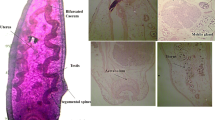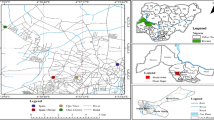Abstract
This study aimed to precisely discriminate Fasciola spp. based on DNA sequences of nuclear internal transcribed spacer 1 (ITS1) and mitochondrial nicotinamide adenine dinucleotide (NADH) dehydrogenase subunit 1 (nad1) gene. We collected 150 adult flukes from the bile ducts of cattle, buffaloes, sheep, and goats from six different regions of Bangladesh. Spermatogenic status was determined by analyzing stained seminal vesicles. The ITS1 types were analyzed using the polymerase chain reaction-restriction fragment length polymorphism (PCR-RFLP) method. The nad1 haplotypes were identified based on PCR and direct sequencing and analyzed phylogenetically by comparing with nad1 haplotypes of Fasciola spp. from other Asian countries. Of the 127 aspermic flukes, 98 were identified as Fg type in ITS1, whereas 29 were identified as Fh/Fg type, indicating a combination of ITS1 sequences of Fasciola hepatica and Fasciola gigantica. All the 127 aspermic flukes showed Fsp-NDI-Bd11 in nad1 haplotype with nucleotide sequences identical to aspermic Fasciola sp. from Asian countries. Further, 20 spermic flukes were identified as F. gigantica based on their spermatogenic status and Fg type in ITS1. F. gigantica population was thought to be introduced into Bangladesh considerably earlier than the aspermic Fasciola sp. because 11 haplotypes with high haplotype diversity were detected from the F. gigantica population. However, three flukes from Bangladesh could not be precisely identified, because their spermatogenic status, ITS1 types, and nad1 haplotypes were ambiguous. Therefore, developing a robust method to distinguish aspermic Fasciola sp. from other Fasciola species is necessary in the future.


Similar content being viewed by others
References
Adlard RD, Barker SC, Blair D, Cribb TH (1993) Comparison of the second internal transcribed spacer (ribosomal DNA) from populations and species of Fasciolidae (Digenea). Int J Parasitol 23:423–425
Agatsuma T, Arakawa Y, Iwagami M, Honzako Y, Cahyaningsih U, Kang S-Y, Hong S-J (2000) Molecular evidence of natural hybridization between Fasciola hepatica and F. gigantica. Parasitol Int 49:231–238
Bandelt HJ, Forster P, Rohl A (1999) Median-joining networks for inferring intraspecific phylogenies. Mol Biol Evol 16:37–48
Bradley DG, Magee D (2006) Genetics and origin of domestic cattle. In: Zeder MA, Emshwiller E, Smith BD, Bradley DG (eds) Documenting domestication: new genetic and archaeological paradigms. University of California Press, California, pp 317–328
Bradley DG, MacHugh DE, Cunninghum P, Loftus RT (1996) Mitochondrial diversity and the origins of African and European cattle. Proc Natl Acad Sci U S A 93:5131–5135
Buntjer JB, Otsen M, Nijman IJ, Kuiper MTR, Lenstra JA (2002) Phylogeny of bovine species based on AFLP fingerprinting. Heredity 88:46–51
Chaichanasak P, Ichikawa M, Sobhon P, Itagaki T (2012) Identification of Fasciola flukes in Thailand based on their spermatogenesis and nuclear ribosomal DNA, and their intraspecific relationships based on mitochondrial DNA. Parasitol Int 61:545–549
Chen S, Lin BZ, Baig M, Mitra B, Lopes RJ, Santos AM, Magee DA, Azevedo M, Tarroso P, Sasazaki S, Ostrowski S, Mahgoub O, Chaudhuri TK, Zhang YP, Costa V, RoyoLJ GF, Luikart G, Boivin N, Fuller DQ, Mannen H, Bradley DG, Beja-Pereira A (2010) Zebu cattle are an exclusive legacy of the South Asia Neolithic. Mol Biol Evol 27:1–6
Chu JK, Kim YK (1967) Taxonomical study on the Fasciolidae in Korea. Korean J Parasitol 5:139–146
Excoffier L, Lischer HEL (2010) Arlequin suite ver 3.5: a new series of programs to perform population genetics analyses under Linux and Windows. Mol Ecol Res 10:564–567
Fu YX (1997) Statistical tests of neutrality of mutations against population growth, hitchhiking and background selection. Genetics 147:915–925
Ichikawa M, Itagaki T (2010) Discrimination of the ITS1 types of Fasciola spp. based on a PCR-RFLP method. Parasitol Res 106:757–761
Ichikawa M, Iwata N, Itagaki T (2010) DNA types of aspermic Fasciola species in Japan. J Vet Med Sci 72:1371–1374
Ichikawa M, Bawn S, Maw NN, Htun LL, Thein M, Gyi A, Sunn K, Katakura K, Itagaki T (2011) Characterization of Fasciola spp. in Myanmar on the basis of spermatogenesis status and nuclear and mitochondrial DNA markers. Parasitol Int 60:474–479
Itagaki T, Tsutsumi K (1998) Triploid form of Fasciola in Japan: genetic relationships between Fasciola hepatica and Fasciola gigantica determined by ITS-2 sequence of nuclear rDNA. Int J Parasitol 28:777–781
Itagaki T, Kikawa M, Sakaguchi K, Shimo J, Terasaki K, Shibahara T, Fukuda K (2005a) Genetic characterization of parthenogenic Fasciola sp. in Japan on the basis of the sequences of ribosomal and mitochondrial DNA. Parasitology 131:679–685
Itagaki T, Kikawa M, Terasaki K, Shibahara T, Fukuda K (2005b) Molecular characterization of parthenogenic Fasciola sp. in Korea on the basis of DNA sequences of ribosomal ITS1 and mitochondrial NDI gene. J Vet Med Sci 67:1115–1118
Itagaki T, Sakaguchi K, Terasaki K, Sasaki O, Yoshihara S, Van Dung T (2009) Occurrence of spermic diploid and aspermic triploid forms of Fasciola in Vietnam and their molecular characterization based on nuclear and mitochondrial DNA. Parasitol Int 58:81–85
Itagaki T, Ichinomiya M, Fukuda K, Fusyuku S, Carmona C (2011) Hybridization experiments indicate incomplete reproductive isolating mechanism between Fasciola hepatica and Fasciola gigantica. Parasitology 138:1278–1284
Kendall SB (1965) Relationship between the species of Fasciola and their molluscan hosts. Adv Parasitol 3:59–95
Kikkawa Y, Takada T, Sutopo NK, Namikawa T, Yonekawa H, Amano T (2003) Phylogenies using mtDNA and SRY provide evidence for male-mediated introgression in Asian domestic cattle. Anim Genet 34:96–101
Kimura S, Shimizu A, Kawano J (1984) Morphological observation on liver fluke detected from naturally infected carabaos in the Philippines. Sci Rept Fac Agr Kobe Univ 16:353–357
Librado P, Rozas J (2009) DnaSP v5: a software for comprehensive analysis of DNA polymorphism data. Bioinformatics 25:1451–1452
Loftus RT, MacHugh DE, Bradley DG, Sharp PM, Cunninghum P (1994) Evidence for two independent domestications of cattle. Proc Natl Acad Sci U S A 91:2757–2761
Marcilla A, Bargues MD, Mas-Coma S (2002) A PCR-RFLP assay for the distinction between Fasciola hepatica and Fasciola gigantica. Mol Cell Probes 16:327–333
Moriyama N, Tsuji M, Seto T (1979) Three karyotypes and their phenotypes of Japanese liver flukes (Fasciola sp.). Jpn J Parasitol 28:23–33, Japanese with English summary
Oshima T, Akahane H, Shimazu T (1968) Patterns of the variation of the common liver fluke (Fasciola sp.) in Japan. I. Variations in the sizes and shapes of the worms and eggs. Jpn J Parasitol 17:97–105 (in Japanese with English summary)
Peng M, Ichinomiya M, Ohtori M, Ichikawa M, Shibahara T, Itagaki T (2009) Molecular characterization of Fasciola hepatica, Fasciola gigantica, and aspermic Fasciola sp. in China based on nuclear and mitochondrial DNA. Parasitol Res 105:809–815
Reddy PV, Subramanyam S (1973) Chromosome studies in the liver fluke, Fasciola gigantica Cobbold, 1856, from Andhra Pradesh. Curr Sci 42:288–291
Sakaguchi Y (1980) Karyotype and gametogenesis of the common liver fluke, Fasciola sp., in Japan. Jpn J Parasitol 29:507–513
Sanderson AR (1953) Maturation and probable gynogenesis in the liver fluke, Fasciola hepatica L. Nature 172:110–112
Spithill TW, Smooker PM, Copeman DB (1999) Fasciola gigantica: epidemiology, control, immunology and molecular biology. In: Dalton JP (ed) Fasciolosis. CABI Publishing, United Kingdom, pp 113–149
Tajima F (1989) Statistical method for testing the neutral mutation hypothesis by DNA polymorphism. Genetics 123:585–595
Tanaka K, Solis CD, Masangkay JS, Maeda K, Kawamoto Y, Namikawa T (1996) Phylogenetic relation among all living species of the genus Bubalus based on DNA sequences of the cytochrome B gene. Biochem Genet 34:443–452
Telford MJ, Herniou EA, Russell RB, Littlewood DT (2000) Changes in mitochondrial genetic codes as phylogenetic characters: two examples from the flatworms. Proc Natl Acad Sci U S A 97:11359–11364
Terasaki K, Akahane H, Habe S, Moriyama N (1982) The geographical distribution of common liver flukes (the genus Fasciola) with normal abnormal spermatogenesis. Jpn J Vet Sci 44:223–231
Terasaki K, Moriyama-Gonda N, Noda Y (1998) Abnormal spermatogenesis in the common liver fluke (Fasciola sp.) from Japan and Korea. J Vet Med Sci 60:1305–1309
Terasaki K, Itagaki T, Shibahara T, Noda Y, Moriyama-Gonda N (2001) Comparative study of the reproductive organs of Fasciola groups by optical microscope. J Vet Med Sci 63:735–742
Terasaki K, Shibahara T, Itagaki T, Fukuda K, Noda Y, Mine M, Motomura A, Yamamoto M (2003) Gametogenesis and fertilization of Fasciola hepatica from Uruguay. J Vet Med 56:97–103 (in Japanese with English summary)
Torgerson P, Claxton J (1999) Epidemiology and control. In: Dalton JP (ed) Fasciolosis. CABI publishing, New York, pp 113–149
Varma AK (1953) On Fasciola indica n. sp. with some observation on F. hepatica and F. gigantica. J Helminthol 27:185–198
Watanabe S, Iwata S (1954) Fasciola species in Japan. J Jpn Vet Med Assoc 7:124–126 (in Japanese)
Acknowledgement
This study was supported in part by a Grant-in-Aid for Science Research (B) and (C) (nos. 23405044, 24580420, and 22405037) from the Ministry of Education, Culture, Sports, Science, and Technology of Japan.
Conflict of interest
The authors declare that they have no conflict of interest.
Ethical standards
The authors declare that the experiments comply with the current laws of the country.
Author information
Authors and Affiliations
Corresponding author
Rights and permissions
About this article
Cite this article
Mohanta, U.K., Ichikawa-Seki, M., Shoriki, T. et al. Characteristics and molecular phylogeny of Fasciola flukes from Bangladesh, determined based on spermatogenesis and nuclear and mitochondrial DNA analyses. Parasitol Res 113, 2493–2501 (2014). https://doi.org/10.1007/s00436-014-3898-5
Received:
Accepted:
Published:
Issue Date:
DOI: https://doi.org/10.1007/s00436-014-3898-5




